Car Audio Fuses Explained – Which Size and Type?
Car audio fuses are critical little devices that keep our car audio and electrical wiring set ups safe. But how do we know which type and size to get?
Many car audio devices offer the exact information in the instruction manual, but if you’re building a complex set up with more than one device, it’s always a good idea to know exactly which fuses to get.
Car fuses are needed for all electronic devices and they come in different shapes and sizes. For bigger devices, such as a car amplifier you’ll need an inline fuse holder that runs through your power wire from the battery. Whereas smaller devices such as an FM transmitter, you’ll need a smaller blade style fuse that will tap into your car fuse box.
For an explanation on different car fuse types, read on, but before we get going, let’s look at why we need a fuse for a car and what they actually do.
Why Do We Need a Fuse for Car Audio?
When we install something like an aftermarket amplifier, we need to run a power lead from the battery to car amplifier. A fuse is used to protect the circuit, which in this case is from the battery to the amplifier.
And even though your new amplifier will have its own fuse to protect it, you still need to put a fuse into the wiring so you protect the wiring from short circuiting, and ultimately your car audio equipment and car from what could turn out to be much worse.
How Do Car Fuses Work?
Car fuses come in many different shapes and sizes, and we can’t just use any size fuse for all set ups. Therefore, it’s important to know what size fuse you need before installing your equipment.
Each car fuse has a small strip of metal, which offers a failure point. For example, if the current going through the fuse exceeds the fuse rating, the small strip of metal will get burnt and cut the circuit. This saves your car audio equipment and possibly your car from getting further damaged.
Different Types of Fuses for a Car
There are several types of fuses for a car that you can use for your car audio system, and depending on the device you’re installing, will determine which fuse you should get.
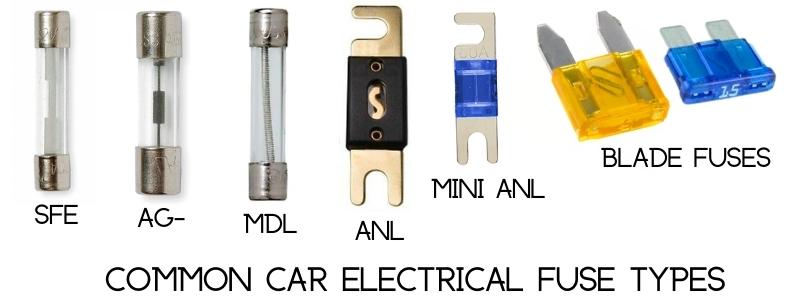
SFE and AG- fuses are the original glass tube fuses. These are fast popping fuses that are fit into your wiring circuit and will cut the circuit as soon as there’s overcurrent. These sit in a spring clamp at each end, but this can become loose over time, so ANL are a better option for this type of fuse.
MDL fuses are similar looking to the glass tube SFE and AG- fuses, but MDL are slower burning, and won’t cut the circuit as quickly.
ANL and Mini ANL are best used for things like amplifiers as they cover ranges up to 500A. Unlike other bolt down fuses, these have a hook end so they’re quite easy to remove, and they don’t suffer from a loosening clamp like the SFE and AG- fuses do. Again, these are used the same way as SFE and AG- fuses as they’re wired into your wiring circuit to protect the wiring if there’s an overcurrent.
ATC, ATL and ATM are what’s known as blade style fuses. They all look very similar, but an ATC fuse is considered to be the standard size and is bigger than the ATL and ATM, which are known as a mini blade fuses and will likely be used for smaller amperage. These fuses are generally used in the car fuse boxes.
Different Types of Car Audio Fuse Holders
There are different types of car audio fuse holders, so it depends which type of car fuse you’re wiring.
An inline fuse holder can be used for all SFE, AG-, MDL, ANL and Mini ANL fuses, but of course they look different due to the car fuse they’re holding.
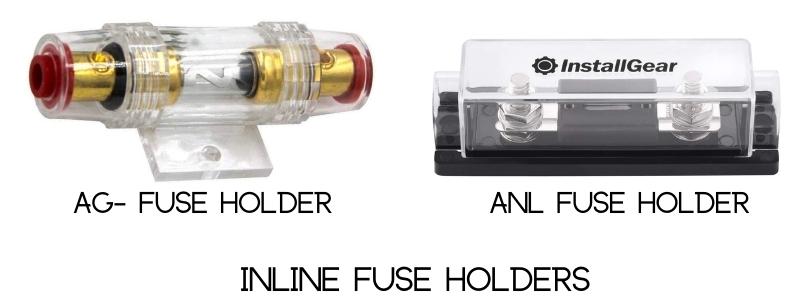
These are generally used with the main wiring and will be located close to the car battery positive terminal, as in the wiring diagram further down.
An inline fuse holder has one input and one output. It should be as close to your battery as possible, and will connect your battery and your car audio device, or to a distributor block if you are powering more than one car audio device.
They come in different sizes, and generally the bigger inline fuse holders can attach to bigger wires, but it doesn’t mean that they can run bigger fuses. Even still, some mini-inline fuse holders do have bigger holes so they can be used with bigger AWG wires.
Distribution blocks are another car audio fuse holder. These do a similar job to typical inline fuse holders, but think of these as an adaptor that allows you to run more wires from.
Generally they have one input and usually up to four outputs, similar to a power adaptor. You can get fused distribution blocks that are useful for running more than one car audio components in the same circuit.
There’s also non-fused distribution blocks, which are good for ground wires. You shouldn’t use these in your power wiring circuit, because the output wire will likely have a smaller current handling capability, and therefore will need a different size car fuse.
You only need a distribution block if you have a more complex car audio set up. For example, if you are only installing a car amplifier, an inline fuse holder will suffice.
However, if you intend to run more devices, such as a second amp and a Digital Signal Processor or a Line Output Converter, you will need a fused-distribution block, as the output wires will need different sized fuses to run them.
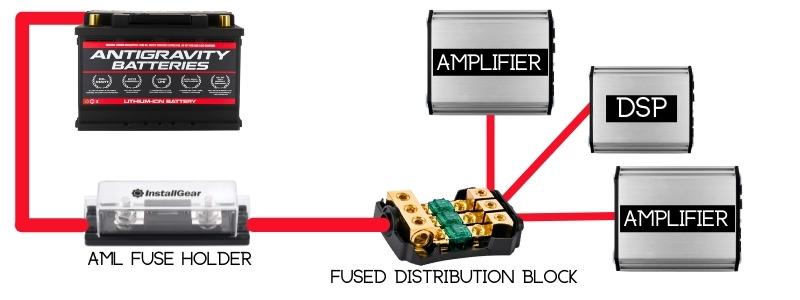
What Size Car Audio Fuse To Get
If you’re running a simple system of let’s say just 1 car amplifier, it’s quite easy to work out the car audio fuse size. If you look at your car amplifier instruction manual, it will tell you what size fuse to use.
It’s really that simple, but if you don’t have the information, you can work it out using the math I = P/V formula below.
If you’re running a complex audio set up with a distribution block it’s a good idea to work out exactly what size car fuses to get to run each device, because each output wire will likely need a different size fuse.
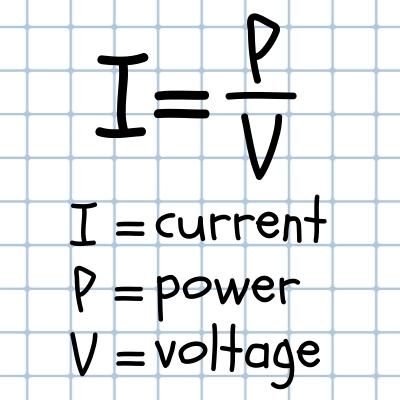
To work it out we do a simple math equation: I equals P over V: I = P/V (I = current; P = power/watts; V = voltage).
So, if you’re running 2 amplifiers and 1 DSP, you’ll need to work the max output of all devices first. To work out the P (power/watts) we need to divide the total by the amplifiers’ efficiency.
In my example, I have a 1000W amp and an 800W amp, that’s 1800W in total. But remember, no amplifier is 100% efficient, so you need to calculate the total by its efficiency. Generally, Class B amps are 80% (0.8) efficient and Class A/B are about 60% (0.6) efficient.
In my example, both amps are Class D, so I will divide 1800 by 0.8 (80% efficiency): 1800 / 0.8 = 2250. Of course, if your amps are Class A/B or a mix of both A/B and D, you should work out the power outage by dividing each one by its efficiency, using the same formula above.
Now this means I need 2250W of power coming into my distribution block to get that 1800W of power outage. And if I add a 60W for my DSP, that means my total power (P) is 2310W.
For the voltage it will be the system’s voltage which is likely 13.8. So, now I need to do the formula: I = P (2350) / V (13.8) = 167.5.
So, according to this formula my inline fuse holder needs a 170A fuse, although a 150A fuse will do as I will never draw all that current at any time.
So, this was the fuse needed for the total system in my inline fuse holder. Now I need to know what size fuse for each of my devices in the fused-distribution block.
My first amp was 1000W, so my math is: 1000 / 0.8 = 1250 / 13.8 = 90.579, so for this I will use a 100A fuse.
For my other amplifier, I need to do the math: 800 / 0.8 = 1000 / 13.8 = 72.46, so for this I would use a 70A fuse.
For my 60W Digital Signal Processor, the math is: 60 / 13.8 = 4.34, so for this I would go for a 5A fuse.
Getting The Right Size Wire fro Your Amperage
For working out the wire size, you need to use the total amperage of each connection and the length of wire you need to determine the gauge wire for each output.
For example for the inline fuse I need a 167A, and if I need 6 feet from battery to distribution block, according to the wire sizing chart below I need 4 AWG wire.
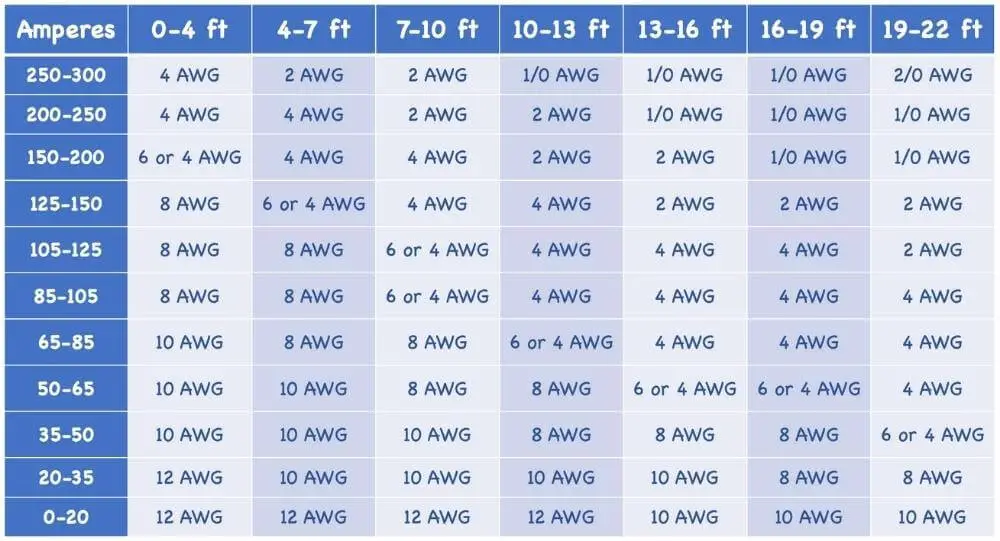
For my 1000W amplifier, let’s say I need 6ft of wire, according to the chart I will need 8 AWG for an amperage draw of 90A.
For my 800W amplifier, let’s say I need 6ft of wire, according to the chart I will need 8 AWG for an amperage draw of 72A.
For the DSP, again, let’s say I need 6ft of wire, according to the chart, I will need 12 AWG for an amperage draw of 5A.
Now you know the size gauge of each wire needed for the run from the distribution block to each car audio device. Of course, every set up is different, but if you use the math formulas above, you can work out the size of each wire and fuse for a car audio set up.
Getting The Right Car Audio Fuse
Getting the right car audio fuse is critical, and much of the information is in your instruction manual. However, when setting up a more complex system of more than one device, it’s important to not only get the right fuse type, but also the right size fuse and the right size wire.
Inline fuses are needed for running the power leads to your device, or distribution block if you’re running more than 1 device.
In that case, the distribution block will host the main power wire, and distribute several smaller wires to your other devices.
Whatever car audio set up you go for ensure you have the right size and correct fuse type. And done correctly, you’ll be able to listen to your music safe in the knowledge all that power you’re drawing will be running efficiently and safely.

I am a passionate and skilled car audio enthusiast with 15 years of experience in the industry. My journey started when I replaced my first set of factory car speakers, sparking a deep love for high-quality sound. Since then, I have worked as a representative for renowned brands like Kenwood and Alpine.
With a background in both retail and distribution, I have developed a comprehensive understanding of the car audio market. Currently a certified (MECP) installer in the Mobile Electronics industry, my expertise lies in delivering top-notch audio installations. My knowledge, coupled with my genuine passion, makes me the go-to professional for all car audio needs.

